

In the late 20th and early 21st century, the United States and some other countries have been beset with "culture wars." If we look at history, though, we can see that culture wars are nothing new. As new cultural values emerge through historical great awakenings, older cultures defend and revive themselves and try to stamp out the new ones. Today's older "traditional" cultures were themselves once the new culture on the block, and they themselves had to battle with older ones to become the dominant, established traditions they are today. It's all part of the process of unfolding human evolution. All the old cultures are still around, and their overwhelming power is felt in the form of the current dominant political ideologies in the United States of America, as well as in other forms around the world-- perhaps especially in the West and Middle East.
Some philosophers today are proposing a new culture or worldview, which they call "integral." This is also called "the theory of everything." Since I see myself as included among these philosophers, I need to understand them and how my approach of the philosophers wheel compares to theirs.
Generally, Integral Philosophy discovers how things fit into a larger whole. It sees conflicts between ideas and outlooks on life, but also how they lead to a higher resolution. This means more than "everything is all one" or "all the same," as many mystics proclaim. It also means seeing all ideas as part of an orderly hierarchy, with each worldview having its own unique value. Some ideas may be older than others, and thus maybe "less progressive" or, on the other hand, more venerable. This article will use some of these ancient and venerable approaches, such as astrology, kundalini, and the kabbalah, as models that illuminate a more-recent version of these ideas-- Spiral Dynamics. The most relevant such model is the mystical ladder of ascent to spiritual transformation and enlightenment, which used the planets as stepping stones in contemplation. I will show that Spiral Dynamics is really the same thing in a modern form, thus integrating the ancient and modern worldview. In effect, the ancients had the course of our evolution already all charted out.
Spiral Dynamics is one of the favorite topics of integral philosophers. It says the universe is evolving and going through stages of development, and so do human beings and human society. This approach is also related to "developmental psychology," whose creators include James Mark Baldwin, Jean Piaget and Abraham Maslow, which claims to trace the stages which individual human beings pass through during their lives. Many integral philosophers propose that our personal life stages mirror those of humanity as a whole. They also suggest that certain groups of people reflect these stages by their behavior and ideals.
Personally, I resist developmental psychology a bit. I don't think all individuals go through the same stages at the same time. People march to the beat of their own drummer, especially today. Many children experience life stages attributed to middle age, and vice versa. People might experience a calling to a higher purpose or an awakening of the spirit as teenagers, or experience adolescence in midlife. Developmental Psychology takes no account of what people might bring in from past lives either; it lacks the esoteric perspective. Also, the stages people go through at a particular time in their lives may depend on how old they are at a particular moment in history. Strauss and Howe have discussed in their books how the generation they are born in, and their generational type, influences the stages they go through in life. For all these reasons I am skeptical of developmental psychology, not only as presented by psychologists, but by other astrologers as well.
But I agree that such generalities and patterns might be interesting, if (as Integral Philosophy proposes) life happens in orders and rhythms, not just randomly. And these patterns and orders, like those I discuss in my other Philosophers Wheel pages, such as the chakras and the medicine wheel, show how all things fit together. Since the way we think and live today is so confused, incoherent and full of conflicts, seeing this larger order is essential. So I will concede some truth to "developmental psychology," but concentrate on how its offspring "spiral dynamics" applies to cultural and political history-- even though Spiral Dynamics too has the well-recognized danger that interpreting some stages as "more advanced" than others could conceal a hidden agenda. I will deal with this as we go along.
Spiral Dynamics, as Steve McIntosh says, is "a pattern of relationships that exhibit systemic properties," not a Newtonian physical law or "material" object. Like all generalities, it has many exceptions and subtleties. Once we understand the pattern, we can see how individuals fit or don't fit, but only if we don't stereotype too strictly. There are always gradations. It depends on your philosophy, as well as your experience and knowledge, whether or not you think these exceptions disprove the existence of any or all of these patterns, theories and generalities! See my article on the philosophy circle for more on this.
Spiral Dynamics leads Integral philosophers to focus on evolution and change through time. This is a more dynamic approach than the comparatively static, eternal symbols like sacred geometry, divine proportions, magic circles, medicine wheels, the tree of life, tarot cards, Jungian or Enneagram types, and even dynamic Bach Toccatas give us. To understand the whole, it seems to say, is to understand how things have developed, and how they might develop in the future. It sees the value of all previous stages, as well as the need to emerge from and transcend their limits.
The background of Spiral Dynamics is very deep and broad. The idea of evolution itself comes from Greek philosophy, as well as from the hermetic, kabbalistic, and neo-platonic writers like Plotinus. It got its scientific expression first from Lamarck in the early 1800s, and then from Charles Darwin and Gregor Mendel in the mid-19th Century. Scientists today such as Francisco Varela, Rupert Sheldrake, Bruce Lipton and others have offered alternatives to Darwinian evolution-- which they say can't sufficiently account for new developments, but only for variation within the old ones. I share this view, and feel strongly that it is unfortunate that genuine critiques of Darwinian evolution are given such little press. In this vaccuum, the critique falls to those who are stuck in outdated worldviews, such as religious fundamentalists. The Bible believers offer some tepid criticisms about gaps in the evidence, and make some valid points about the moral effects of evolution theory, but offer nothing to replace Darwin except their own authoritarian beliefs. Darwin can only be replaced or revised with new theories that have some basis in truth, not belief. Meanwhile we are left with the useless and destructive "culture wars."
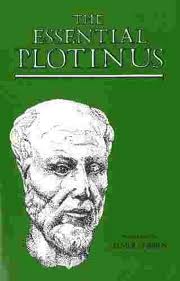

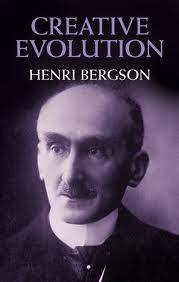


Henri Bergson, that very foundational early-20th Century philosopher, proposed Creative Evolution, as the alternative to Creation (aka Intelligent Design) and Evolution (aka Darwinism). This is the main point of Integral Philosophy. Evolution (including human evolution and history) is the story of an ongoing process of creation reaching ever-more conscious levels, not simply a random outcome of mechanical causes like gene mutation and natural selection. But this also means life is not the fully-developed product of a supernatural creation that happened in the past, once and for all. Other great philosophers who have laid the foundations for Spiral Dynamics, whose work I won't discuss here, include Pierre Teilhard de Chardin, Sri Aurobindo, and Alfred North Whitehead, creator of "process philosophy." Also, we can't forget the German idealists, especially Georg Hegel (1770-1831), who showed how history could be seen as a succession in which one stage would give rise to a conflicting one, followed by a synthesis that would become the next stage. You can find Darwin, Hegel, Teilhard, Bergson and Whitehead placed on my philosophers wheel. These above philosophers have all been influential in many fields, and on many other writers.
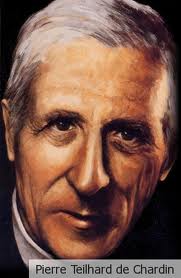
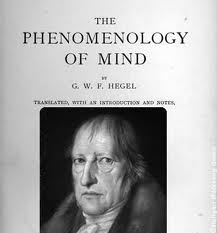
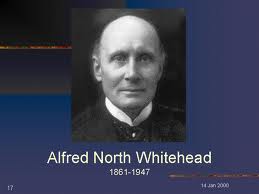


Lesser-known researchers and theorists have also contributed. Best known today is Ken Wilber (b.1949), who is developing his own "theory of everything" and proposing many ways in which different ideas fit together, including "circles" and "quadrants" that resemble the philosophers wheel. I think the work of Thomas Kuhn in The Structure of Scientific Revolutions is important. Swiss philosopher Gene Gebser (1905-1973), psychologist Gustav Fechner (1801-1887), and especially the modern psychologist Clare Graves (1914-1986) made important contributions. In 1996 Graves' students Don Beck and Chris Cowan laid out the eight stages of Spiral Dynamics often cited today, and which we will review below.

Others include Robert Kegan and Allan Combs. Michael Wayne's 2005 book Quantum Integral Medicine has been an important background source for this webpage, as have been Karen Engelsen's 2004 article in Edge Life entitled "The Next Step in Evolution: Exploring the Organizing Principles that Continue to Structure our Mindset", and Steve McIntosh's 2007 book Integral Consciousness and the Future of Evolution (follow links to see book excerpts).
Before I fulfill my main purpose here and compare each stage of Spiral Dynamics to the meanings of the planets in astrology, and thereby expand its meaning, let's look briefly at Spiral Dynamics as originally given and how it has shaped our culture and worldviews.
Before doing that though, let's notice that of all the symbols I have discussed elsewhere, it is clear that the chakra system is the one most nearly related to Spiral Dynamics. The chakra system is the series of 7 major (and other minor) centers of energy and consciousness located up and down along the human backbone. As of now I don't know if any of the founders or exponents of Spiral Dynamics are aware of the chakras. Of course, the two currents that move up and down these chakras move in a spiral or helix fashion, switching places at each chakra; and each chakra represents a "stage" from a more earthly to a more spiritual type of consciousness. Anodea Judith in her books and website, as well as other authors, have said clearly that the chakras correspond to developmental stages in both the individual and society. The chakras also alternate between yang or assertive, and yin or receptive, as they go up; starting with a yang chakra first.
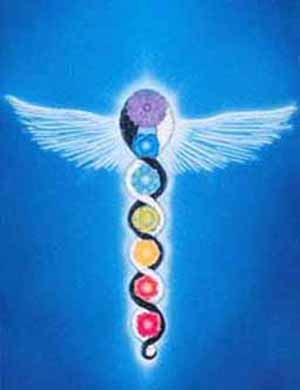
As you can see on Steve McIntosh's website and the excerpt from his book on Spiral Dynamics, a spiral is used to illustrate the theory in which the stages move back and forth, first an assertive, more "individualistic" stage, then a more submissive, "group-oriented" stage. These correspond to yang and yin respectively. There are eight stages in all, but the final stage is a hypothetical one that hasn't happened. In Karen Engelsen's account, the 7th and 8th stages are called "twins." Since one of these final stages is called "holistic" and the other "integral," and since these words mean the same thing, I think we can safely say that, in fact, Spiral Dynamics outlines 7 stages, equal to the 7 centers of the chakra system. Further stages would correspond to chakras that some visionaries say lie above the head; or to a return downward to reintegrate the lower stages.
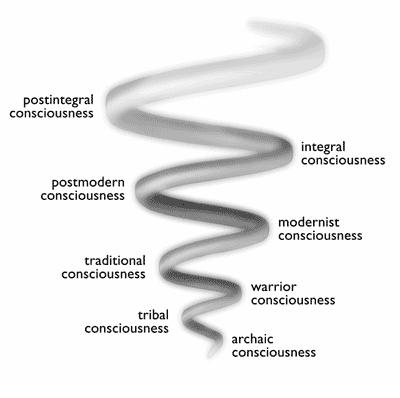
So, adding the 7 chakras to my description, lets start with the first stage. Just like chakras, each is given a color and different names by various authors (but the colors of Spiral Dynamics and chakras are different). These stages are also called memes, a word coined by biologist and atheist philosopher Richard Dawkins, meaning an idea or a worldview that has been transmitted across people and cultures and has programmed their behavior, much as a virus or a gene with DNA replicates in the human body. Memes are sometimes defined as catchy, persuasive slogans or images that influence people, but Spiral Dynamic memes direct the activities of entire cultures and civilizations, instilling beliefs and mindsets among their people. Spiral Dynamics also call them vMemes, meaning value memes, or greater frameworks for the beliefs that "arise and circulate" within our culture.
1. Beige: Archaic-Instinctual. At this stage the first human societies have emerged and are preoccupied with basic survival. People depend on instincts, and there is little sense of self or the group. This meme is yang and corresponds to the first, root chakra at the base of the spine which is concerned with survival and grounding.
2. Purple: Magical-Tribal. At this stage people form into tribes. The animistic, magical worldview predominates, in which the world is seen to be made up of and populated by spirits. Among them are the ancestors who guide and bond the tribe together. Magic is used to cast spells to appease the spirits who might bring good or bad events. Ethnic beliefs and family rituals are predominant. This yin meme corresponds to the second, genital yin chakra of sensuality, bonding and desire.
3. Red: Warriors and Power Gods. At this stage, the world is seen to be full of threats. Emperors conquer territories and try to defeat other lords and emperors. They dominate and inspire the people to go to war and accomplish great feats. These lords and warriors develop humanity's first sense of an independent self, which seeks power and glory. The Gods and Goddesses of this meme are powerful and remorseless; meanwhile on Earth vast battles kill thousands and release rape and pillage. Male gods and rulers are venerated; patriarchy arrives and continues in several succeeding memes. This yang meme corresponds to the third chakra of power and will at the solar plexus and navel.
4. Blue: Righteous or Mythic Order and Tradition. Primarily dominant in the Middle Ages, at this stage authority and morality is used to subdue and direct the aggressive, self-centered Red meme. The people submit to God-given written moral codes of conduct based on absolute, divine principles of right and wrong. This order comes primarily from authoritarian religion, though sometimes other kinds of Orders can inspire the same devotion and obedience. Guilt is used to curb impulses, and those who don't believe the same way are often ostracized or killed when they can't be converted by missionaries. This yin stage corresponds to the fourth chakra of the heart: devotion and relationship.
5. Orange: Achievement-Modernist. At this stage the spiral swings back toward self-assertion, in the form of competition in the emerging capitalist society. Science and inquiry are freed from the dogma of the previous religious meme. The goal, elucidated in The Enlightenment in the 17th and 18th Centuries, is material progress attained by mastering the mechanical laws of nature, and by developing and applying technology and other means to control and manipulate the world. These goals are facilitated by freedom of thought, and by free enterprise and the free market. Whereas the previous stage depended on faith, now objective and rational proof is required. The rule of the Middle Class and liberal democracy replaces the Emperors and Priests. The dominant religion is secular humanism. This yang stage corresponds to the fifth chakra at the throat that represents expression through thought, rational mind and language.
6. Green: Community, Sensitivity, Egalitarian, Post-Modern. Karen Engelsen and the wikipedia article on Spiral Dynamics said this stage emerged in the mid-19th Century, and she included in it the Communist and Socialist systems that opposed the Achievement-oriented Free Market. McIntosh and others, however, date the Green meme from the 1960s. At this stage people seek to recover the sensitive, lost self which was separated and alienated from Nature by the previous meme, and to restore the sense of Community destroyed by capitalist competition. New communities based on common values and consensus are chosen. Cultural Creatives drop out of competitive society (the rat race) to seek spirituality and develop sensitivity and human potential. Feeling and caring are valued above cold thinking and manipulation. Hierarchy is rejected in favor of unity of all people on one restored Earth. In Deep Ecology we not only seek to regain our respect for all living beings, but to reject human domination of the world and of one group over another. Peace and environmentalism advance. Respect for diversity and political correctness are proclaimed, and sometimes enforced. Multi-cultural and pluralistic, the Green meme is tolerant and rejects absolutes. The rise of feminism finally overthrows patriarchy. The Green stage is yin and corresponds to the 6th chakra of vision and imagination at the third eye.
7. Yellow: Integral (and Turquoise: Holistic). At this final yang stage, respect for hierarchy and natural degrees of ranking and excellence returns to complement equality and diversity. An ultimate sense of absolute truth is restored, not as dogma but as an indefinite, emerging purpose guiding human and world evolution. Instead of the confrontation with older worldviews in the "culture wars," which captivate many who function at the blue and orange stages and some at the green stage, the different views are seen as part of the up and down currents of the dynamic spiral. All stages are necessary and answer a need within the on-going process of human evolution and development. In the Yellow meme we know that the world is one whole being with one mind, but also made up of distinct individuals who are themselves whole beings. Feeling and thinking, and science and religion, interact in fruitful relationship, as the different stages of Spiral Dynamics are woven into a single conscious system energized by harmonics and "mystical" forces. Governments seek to encourage people to evolve and emerge from their own level (nested hierarchy). This meme corresponds to the seventh or crown chakra of spiritual realization and knowledge. Some people entered this stage in the 1990s, according to the authors of Spiral Dynamics. Dividing this final stage into two parts, they consider the Yellow Integral stage to emphasize the individual, like the Orange meme, but recognize the community, while the Turquois Holistic meme emphasizes the community, like the Green meme, while also recognizing the individual.

I notice that the choice of colors for these stages or memes has a distinct purpose. They don't necessarily correspond to the meaning of colors in other systems. The yang or assertive memes are given bright or hot colors, and the yin, submissive-to-group memes are given darker or cooler ones. The early or base memes, after "beige," start with adjoining colors at the red end (red and purple), but by the time you get to the blue and orange memes the colors are polar opposites across the color wheel. This corresponds to the dualism between religion (blue) and science (orange) which helps cause the "culture wars" of today. But at the top end of the spiral the colors green and yellow are again adjacent colors on the wheel, showing greater harmony and resolution as we move up the spiral, thus reaching toward the goal of integral philosophy. Readers of my Toccata essay might notice that this pattern is exactly replicated in the Toccata in F's theme and its overall organization.
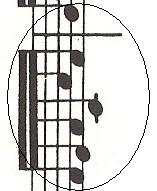
Above: Toccata in F theme shown upright.
| Color | chakra | Stage/Meme | Description | Rulership/Politics | Approximate Epoch |
| Yellow | 7 (yang) | Integral/Holistic | transcend and include all levels | nested hierarchy | since 1990s |
| Green | 6 (yin) | All One People | feeling-oriented, pluralistic | environmentalist, peace movement | since 1960s |
| Orange | 5 (yang) | Achievement | rational, secular, capitalist | democracy, middle class, "free" market | since 17th/18th century "Enlightenment" |
| Blue | 4 (yin) | Religious Order | moral laws and beliefs | church | since Christianity |
| Red | 3 (yang) | Warrior | aggressive | emperors and war lords | since Bronze Age |
| Purple | 2 (yin) | Magical | animistic | tribes | since time of cave paintings |
| Beige | 1 (yang) | Instinctive | survival oriented | first societies emerge |
Chakra dynamics:
yang/aggressive: 1,3,5,7
yin/submissive or group-oriented: 2,4,6
With my background in philosophy, history and astrology, I have noticed that the stages described by Spiral Dynamics can be very powerfully symbolized and brought to life by the planets. Here I am not usually referring to the influence which planets are reputed to have in astrology, but instead using them as powerful symbols of the stages in history and the meaning and structure of life. If I make a few correlations to planetary cycles here, which may interest some folks, those who don't accept such "influence" can safely ignore these and just focus on the symbolism. The astrological meaning of these planets is known to many people, even if not known to many others. But the great 1914 symphonic poem by Gustav Holst illustrates the symbolic significance of the planets given by astrology very vividly for us, and most people are familiar with this music.
Hear The Planets on You Tube:
Mercury
Venus
Mars
Jupiter
Saturn
Uranus
Neptune
The Planets, complete with good pictures and description of the piece (not available at the moment)
I have summarized the meaning of the planets here at my other web page.

The idea that there is a "ladder of planets" has been covered on some of my other pages, as well as in Robert Place's book on The Tarot. Many ancient mystics used the planets to contemplate a "ladder" from the earth to heaven, where they believed higher consciousness could be found. They postulated that the soul came down to earth to be born on this ladder, and would return by climbing it back, and that through contemplation they could anticipate this journey. At each planet they would receive or release certain traits. Thus each planet, even then, was thought of as a "stage" on the way from ordinary consciousness to the divine. This is just what Spiral Dynamics wishes to show has been happening on a larger scale through human evolution and history.
Let's review briefly the meaning of the planets in astrology, climbing up as we go the ladder of planets one way. There are two directions in which to climb the ladder, and each direction or current can be interpreted as taking us either up toward the divine or downward toward manifestation on Earth. Unlike in the chakra system, in Spiral Dynamics the order of the planets seems to fit the climb outward to the stars, rather than the climb inward from the dark outer planets to the Sun or the Earth. This may be because this is a collective, rather than just an individual ascent. So that is the direction we will climb the ladder now. The symbol or glyph for each planet is also indicated.
![]() The Sun is the center of the solar system, the basic source of our life and energy. It represents the glory attributed to the Father-God Creator or to the creative force of life. It is noble, dramatic and expressive.
The Sun is the center of the solar system, the basic source of our life and energy. It represents the glory attributed to the Father-God Creator or to the creative force of life. It is noble, dramatic and expressive.
![]() The Moon represents our instincts, emotions and feelings. Symbol of family and the Mother goddess, she nourishes life and provides for basic needs. More unstable than the Sun, the Moon reflects the Sun's rays and rules the fluctuating tides. It appears to wax and wane in its light.
The Moon represents our instincts, emotions and feelings. Symbol of family and the Mother goddess, she nourishes life and provides for basic needs. More unstable than the Sun, the Moon reflects the Sun's rays and rules the fluctuating tides. It appears to wax and wane in its light.
![]() Mercury is named after the ancient God Hermes or Thoth. He is the Magician who brings knowledge to humanity. He is the winged messenger who represents writing, communication and rational thought. Mercury symbolizes brethren and neighbors as well as short journeys.
Mercury is named after the ancient God Hermes or Thoth. He is the Magician who brings knowledge to humanity. He is the winged messenger who represents writing, communication and rational thought. Mercury symbolizes brethren and neighbors as well as short journeys.
![]() Venus is the goddess of love and the productive powers of nature who represents the sensuous allure of feminine beauty and sexuality. She represents art, but also money and values generally. She brings diplomacy and peace, and she balances and evaluates.
Venus is the goddess of love and the productive powers of nature who represents the sensuous allure of feminine beauty and sexuality. She represents art, but also money and values generally. She brings diplomacy and peace, and she balances and evaluates.
![]() Mars is the god of war. He stirs up trouble and rouses us to action and adventure. Mars represents conquest and the courage and strategic skill to defend against our enemies. He represents male sexual desire, and the strong sense of ego and individuality. He gives us the energy and desire to fight inner battles as well as outer ones.
Mars is the god of war. He stirs up trouble and rouses us to action and adventure. Mars represents conquest and the courage and strategic skill to defend against our enemies. He represents male sexual desire, and the strong sense of ego and individuality. He gives us the energy and desire to fight inner battles as well as outer ones.
![]() Jupiter is the jolly giant among the planets. He brings us wealth, wisdom, and celebration in pageantry, ceremony and ritual. Jupiter expands our perspective so that we can understand the moral laws that govern society. Jupiter represents organized religion and the priesthood as well as philosophy and the Higher Mind generally. He is the ultimate "joiner," but also sends us on long journeys and travels. He has the exhuberant faith and confidence to dream and act big.
Jupiter is the jolly giant among the planets. He brings us wealth, wisdom, and celebration in pageantry, ceremony and ritual. Jupiter expands our perspective so that we can understand the moral laws that govern society. Jupiter represents organized religion and the priesthood as well as philosophy and the Higher Mind generally. He is the ultimate "joiner," but also sends us on long journeys and travels. He has the exhuberant faith and confidence to dream and act big.
![]() Saturn represents law and order. Where Jupiter is the Church, Saturn is the State. Saturn organizes, controls and restricts us. He sets boundaries and rules. Saturn is very realistic, worldly, pessimistic, practical and down-to-earth; the teacher and task-master. Saturn is ambitious and seeks status and power. He is the god of old age and Father Time, and the favorite of kings, high officials and petty bureaucrats. People ruled by Saturn are thinkers who follow well-trod procedures and formulas, and may be dogmatic or limited in their outlook to what is traditional or strictly demonstrated by science and precedent.
Saturn represents law and order. Where Jupiter is the Church, Saturn is the State. Saturn organizes, controls and restricts us. He sets boundaries and rules. Saturn is very realistic, worldly, pessimistic, practical and down-to-earth; the teacher and task-master. Saturn is ambitious and seeks status and power. He is the god of old age and Father Time, and the favorite of kings, high officials and petty bureaucrats. People ruled by Saturn are thinkers who follow well-trod procedures and formulas, and may be dogmatic or limited in their outlook to what is traditional or strictly demonstrated by science and precedent.
Here is a great introduction to the meaning and evolution within humanity of these inner visible planets on you tube by Vic DiCara
![]() Uranus is the revolutionary, awakener and non-conformist. Discovered in 1781, the year the United States won its independence on the eve of the French Revolution, Uranus is the planet of liberty and freedom, and the champion of individual rights and progress. It thus represents the power of the Middle Class or Bourgeoisie unleashed by the revolutions both political and industrial, and its competitive individualism and self-reliance, but also of all those who continue to rebel against established authorities-- even those who were once the revolutionaries themselves. This fact is what gave Hegel his idea about conflict and synthesis through history, which was passed on to Karl Marx. Uranus is inventive, investigates both science and the occult, and looks outside the boxes and boundaries set by Saturn. He represents the unexpected and overturns lots of applecarts. Uranus is the inner light of discovery. It is equivalent in meaning to Rahu in Vedic astrology.
Uranus is the revolutionary, awakener and non-conformist. Discovered in 1781, the year the United States won its independence on the eve of the French Revolution, Uranus is the planet of liberty and freedom, and the champion of individual rights and progress. It thus represents the power of the Middle Class or Bourgeoisie unleashed by the revolutions both political and industrial, and its competitive individualism and self-reliance, but also of all those who continue to rebel against established authorities-- even those who were once the revolutionaries themselves. This fact is what gave Hegel his idea about conflict and synthesis through history, which was passed on to Karl Marx. Uranus is inventive, investigates both science and the occult, and looks outside the boxes and boundaries set by Saturn. He represents the unexpected and overturns lots of applecarts. Uranus is the inner light of discovery. It is equivalent in meaning to Rahu in Vedic astrology.
![]() Neptune, discovered in 1846, represents the social advances of the 19th Century, just as Uranus represents those of the 18th. It has always been associated by astrologers with socialism and communism and other programs intended to help the poor and the working class. It is the symbol of boundless compassion and the genuine humanitarian attitudes and activities that emerged in the period of its discovery. It also represents the yearnings of the mystic to seek spiritual enlightenment and dissolve and transcend boundaries and limits. It extends migration and commerce all over the globe. It represents greatly heightened sensitivity, expressed in the most subtle art forms, but also escapism through alcoholism, drugs, deceit, or other forms of decadence. It is equivalent to the Vedic Ketu.
Neptune, discovered in 1846, represents the social advances of the 19th Century, just as Uranus represents those of the 18th. It has always been associated by astrologers with socialism and communism and other programs intended to help the poor and the working class. It is the symbol of boundless compassion and the genuine humanitarian attitudes and activities that emerged in the period of its discovery. It also represents the yearnings of the mystic to seek spiritual enlightenment and dissolve and transcend boundaries and limits. It extends migration and commerce all over the globe. It represents greatly heightened sensitivity, expressed in the most subtle art forms, but also escapism through alcoholism, drugs, deceit, or other forms of decadence. It is equivalent to the Vedic Ketu.
![]() Pluto, discovered in 1930, is the planet of the 20th Century, and the god of all forbidden fruits of the Underworld. It represents vast cycles of death and rebirth in civilization and its power structures. It plumbs the depths to release explosive, pent-up, hidden powers in order to bring new life into the world. Depth psychology and Existentialism, as well as bioenergetics, relativity, quantum physics and atomic energy, are typical Plutonian manifestations. It destroys the old to make way for the new. Whereas Uranus awakens us with new insight, and Neptune expands our consciousness to the ultimate limits, Pluto gives us the persistence and concentration we need for spiritual practice. Pluto forces us to confront nothingness so that we may become transformed and renewed. It brought a holocaust/world war which also released unimagined wealth and power. By showing us the futility of polarization and atomic weapons, I think it is also a symbol of peace, and in its bent for transforming the old into the new, and its accent on interdependence, it stands for ecology, recycling and alternative energy.
Pluto, discovered in 1930, is the planet of the 20th Century, and the god of all forbidden fruits of the Underworld. It represents vast cycles of death and rebirth in civilization and its power structures. It plumbs the depths to release explosive, pent-up, hidden powers in order to bring new life into the world. Depth psychology and Existentialism, as well as bioenergetics, relativity, quantum physics and atomic energy, are typical Plutonian manifestations. It destroys the old to make way for the new. Whereas Uranus awakens us with new insight, and Neptune expands our consciousness to the ultimate limits, Pluto gives us the persistence and concentration we need for spiritual practice. Pluto forces us to confront nothingness so that we may become transformed and renewed. It brought a holocaust/world war which also released unimagined wealth and power. By showing us the futility of polarization and atomic weapons, I think it is also a symbol of peace, and in its bent for transforming the old into the new, and its accent on interdependence, it stands for ecology, recycling and alternative energy.
Uranus, Neptune and Pluto, which are invisible to the naked eye (though a "sharp-eyed observer" can see Uranus), orbit in a 1-2-3 resonance. This means that it takes Neptune about twice as long to orbit the Sun (165 years) as Uranus does (84 years); and Pluto takes 3 times as long (248 years). So I have called them the transcendental trinity.
See the chapter called Prophetic Tool Kit from my 1997 book Horoscope for the New Millennium for more on these and the visible planets.
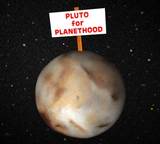
As of this writing in 2008-2010 there is controversy over whether Pluto is a planet. This is because in the 15 years before 2008 many other smaller bodies have been discovered far out in our solar system, orbiting in what is called the Kuiper Belt or even beyond, the region where comets come from. One of these objects, (Eris) may be as big as Pluto. Even in 1930, one astronomer forecast that Pluto was just one of many objects in its region. In defending Pluto's status, I say that none of these other bodies has such a large Moon (Charon; the two together may be larger than Eris). Pluto's relationship with Charon is astounding, and confirms much of what is said about Pluto by astrologers. They are "locked together" more closely than any other bodies in the solar system. Charon orbits Pluto and rotates on its own axis at exactly the same rate; about 6-plus Earth days. Pluto also rotates on its axis at the same speed. Thus Charon is always in the same place in Pluto's sky, showing the same face, and Pluto is always in the same place in Charon's sky too. Imagine, if you were standing on Pluto, seeing the same side of a huge moon in the same place in the sky, day and night, year after year. This can represent obsession, concentration, power, polarization, structuring, synthesis, and inter-relationship or ecology, characteristics which astrologers noticed through their experience with Pluto in horoscopes even before Charon was discovered. For example, in Fritz Brunhubner's textbook on Pluto, written as early as 1934, and published by AFA in 1966, he described Pluto as "a polarity" which has "a double face" with "contrasts (which) combine." (p.13). Pluto's passage inside Neptune, far from disqualifying it, is one of the most powerful and historically-significant symbols in the solar system, representing rebirth. Pluto's recent closest passage to the Sun and Earth coincided with the greatest liberation the world has ever seen (the 1989-era movements), as I predicted it would.
Other planets also have other important minor planets crossing their orbits (for example, Chiron and the other centaurs cross Saturn, Uranus and Neptune). Neptune and Jupiter also have some objects that follow it around (Trojans). Given all this, it is hard to see how "clearing its orbital neighborhood" can be the definition of a planet, as is claimed, when all the other planets beyond Earth have not "cleared their orbits" either. It is, apparently, a matter of degree of "clearing" in relation to the size of the planet, and of how one defines the "neighborhood." In any case, astrologers certainly cannot dismiss Pluto, even if some astronomers don't call it a planet anymore; we know that its significance has been demonstrated beyond all doubt. The largest object in the Kuiper Belt, Pluto is the primary link or way-station between planets and minor planets, the planets and beyond, or life and after-life.
![]() Chiron, discovered in 1977, was the first "minor planet" besides the asteroids to be discovered after Pluto. Pluto's Moon Charon was discovered a year later. This icy asteroid called Chiron moves between the orbits of Saturn and Uranus, and even beyond them. It thus has been given the traits of a "rainbow bridge" or "key" between the visible and invisible realms by astrologers. Its discovery happened when many keys and tools of transformation emerged, both ancient and modern, within the New Age and Human Potential movements, as well as to when personal high tech began (Apple Computer was founded in 1977). Chiron is also called the "wounded healer," representing wisdom gained through integrating and healing the wounds and chaotic conditions of life. Similar objects to Chiron have been discovered since 1992 in the same area; they are called centaurs, since in mythology Chiron was a centaur. Several of them, including Chariklo and Pholus, are now believed to be larger than Chiron. They may continue in these orbits for only 1 to 10 million years, having descended from beyond Neptune and Pluto, perturbed by their orbits; after which they may fall below Jupiter and become comets.
Chiron, discovered in 1977, was the first "minor planet" besides the asteroids to be discovered after Pluto. Pluto's Moon Charon was discovered a year later. This icy asteroid called Chiron moves between the orbits of Saturn and Uranus, and even beyond them. It thus has been given the traits of a "rainbow bridge" or "key" between the visible and invisible realms by astrologers. Its discovery happened when many keys and tools of transformation emerged, both ancient and modern, within the New Age and Human Potential movements, as well as to when personal high tech began (Apple Computer was founded in 1977). Chiron is also called the "wounded healer," representing wisdom gained through integrating and healing the wounds and chaotic conditions of life. Similar objects to Chiron have been discovered since 1992 in the same area; they are called centaurs, since in mythology Chiron was a centaur. Several of them, including Chariklo and Pholus, are now believed to be larger than Chiron. They may continue in these orbits for only 1 to 10 million years, having descended from beyond Neptune and Pluto, perturbed by their orbits; after which they may fall below Jupiter and become comets.
The controversial reduction in status of Pluto to a dwarf planet occured around 2006, just when politics in America seemed in full retreat from all the advances of the 20th Century (and it still is). Perhaps all of Pluto's forbidden fruits were being put back in the closet or buried underground again, even as Pluto began its trek back into the depths from its nearest passage to us in 1989. Thus everything from socialism, and its watered-down applications in America like the New Deal and the Great Society, to pluralism and tolerance of other religions, to restoring the environment, to releasing repressed and primitive energy, to spiritual awakening and cultural experiments, and above all the realizations of the peace movement, were all being denounced and destroyed by the Bush administration and the Republicans (and now even more clearly by Donald Trump). Even science was in retreat. Just as Pluto in its new lower status now has to fight for recognition, so do all the progressive advances of the 20th century.
On the other hand, all this regression, which had been building momentum since the late 1970s when Chiron and Charon were discovered, and launched in earnest by the ascension of the reactionary Ronald Reagan, might yet fulfill some purpose in the larger scheme of things. We can symbolize this with Chiron, since in effect it has put us back below Uranus again, with the aim of rediscovering some of the lost values of earlier memes. If one of these days, instead of just regressing and going back to them, as has been happening under Bush and the Republicans, we can include and also transcend these earlier stages, saving what is valuable and discarding the rest, then some healing of our nation and world could occur. Chiron "the wounded healer" centaur, and the other "centaurs," can thus symbolize the integration made possible by moving down from the transcendent memes in the invisible realms back into traditional memes in visible realms, while discovery of Eris and the Kuiper belt represents the "holistic" transcendent meme that is now in the ascendant.. Chiron also represents all the older ancient methods of esoteric knowledge, like astrology, the chakras, the kabbalah, and ancient mysticism and shamanism, now being rediscovered since at least the 1970s when Chiron was discovered.
The first object of the Kuiper belt after Pluto was discovered only in 1993. This Belt includes many objects similar to Pluto, all made of ice and rock, but smaller. About 1000 objects have been found in it so far. That could be very symbolic, since the internet started the same year (also the year of Uranus' conjunction to Neptune). The vast Kuiper Belt reminds us of the "cloud" of computers now connecting our planet into one cyber-mind. Though many of these objects have a similar composition to Pluto, there is also great "diversity."
Eris, discovered in 2003, has a very ecliptic and uncircular orbit that takes it far beyond the Kuiper belt, and then back again inside the farthest reaches of Pluto's orbit. Eris is about as large as Pluto by itself (recent information is that it isn't "larger" than Pluto). It's discovery was the occasion for Pluto's demotion from planethood. It is said by astrologers to be "quarrelsome," which would fit in with the crazy and unnecessary Iraq War launched by Bush in 2003. But does Eris have a higher meaning, just as Pluto once stood for the holocaust and nuclear weapons, but now represents peace and ecology? Eris takes about 560 years to orbit the Sun. Some other smaller objects have similar orbits to Eris, and others may be found. It could be that, just as Chiron's discovery represented the start of regression that brought us below Neptune again in our consciousness (the Reagan reaction and the potential "integration" of older memes), so Eris' discovery in 2003 might represent the renewed questioning of the Reagan-Bush regression after Hurricane Katrina and the War in Iraq, and our resumed quest to expand our collective consciousness upward again and connect with the galaxy. Eris is considered one of the scattered disc objects, the next group beyond the Kuiper Belt, although like some others it also comes inside the Kuiper Belt toward its perihelion (closest point to the Sun).
Much further out, up to about 12 times more distant from the Sun than the Kuiper belt, Sedna is about a third the size of Pluto. It has a very eccentric orbit lasting about 12,000 years, and is now approaching perihelion. It is part of the Oort Cloud, the farthest belt in the solar system from which most comets originate.
There are three other known objects in the Kuiper Belt that are about 1/3 to 1/5 the size of Pluto: Haumea, Quaoar and Makemake (according to wikipedia). They all orbit the Sun at about Pluto's most distant point from the Sun. Together with Ceres, the largest spherical body in the asteroid belt between Mars and Jupiter, these largest minor planets (except so-far, Quaoar) are now called "dwarf planets" by most astronomers. Those beyond Neptune are called plutoids. Pluto also has about 200 "companions" called Plutinos. They orbit the Sun at the same rate as Pluto, having the same relationship of 2 orbits for every 3 of Neptune. Thus they confirm the significance of the length of Pluto's orbit. Some of them also pass inside of Neptune, and some have orbits as eccentric and far-inclined as Pluto's. They are all no more than about 20 to 40 times smaller in mass than Pluto. The largest plutinos are named Orcus, Huya and Ixion.
Orcus has an orbit that compliments Pluto's. I don't know it's exact position yet. It may have made a conjunction to Neptune around 1760 (7 Years War), and does so once every 494 years. It's most recent opposition to Neptune may have been around 2007. It's latest conjunction to Uranus could have been around 1948-49 (Chinese Revolution?). It comes closest to Earth in early Pisces or sidereal Aquarius (it last did so around 1890, also the time of Neptune's conjunction to Pluto), and is approaching aphelion (farthest away) now.
Some of the centaurs like Chiron may have been former Kuiper Belt objects cast downward by Pluto's gravity pull, confirming Pluto's role as "lord of the underworld." There are a few other "resonances" (ratios) to Neptune followed by some Kuiper belt objects, but Pluto's 2 to 3 ratio is the most common and significant. Remember this is also a 1 to 3 resonance with Uranus at the same time. The majority of other Kuiper Belt Objects don't follow any orbital resonance with other planets. Discovery of all these objects may confirm what integral philosophers say: that the 1990s represent the beginning of the integral phase (or the early ascendancy of the holistic phase). But I date the integral meme from discovery of Chiron in 1977, first of the new bodies to be discovered after Pluto. By the later 1960s and early 1970s, when the green meme began to emerge, Pluto was coming into sharper focus as it approached its closest point to Earth, and we learned that Pluto was much smaller than first thought. After Pluto's moon Charon was discovered in 1978, the size of Pluto was confirmed, and it became clear that we had been seeing Pluto and Charon together in a larger fuzzy image. Perhaps that means, in the emerging "integral" meme since 1977-78, we are now seeing the green meme in a clearer perspective as well.
The main point I am making is revealed by the obvious difference between Spiral Dynamics and Astrology. There are 7 memes, but 10 planets. In fact, in looking at these 7 Spiral Dynamics stages, it seemed to me that three important historical stages were missing. Besides the 7 chakras, another esoteric model came to mind here, and that is the Kabbalah's Tree of Life, which has the same 7 levels like the chakras, but consists of 10 circles (the Sephiroth). There is also a shadowy 11th circle (Daath). In the Tree of Life symbol, there are two circles instead of one on three of the levels. I decided to lay out my revised version of Spiral Dynamics on the Tree of Life diagram instead of a straight spiral to represent the successive stages in human evolution and history.
The right side of the Tree is flowing and merciful (these are the yin phases, although traditionally called masculine), and the left side is intellectual and formal (yang phases, but traditionally considered feminine). These are also called the pillar of mercy on the right, and the pillar of severity of the left. The circles in the middle pillar represent integration and balance. Thus, the "communal" phases are the circles on the right, and the "individualist" phases are the circles on the left. The only difference from the spiral dynamic is that Mercury (tribal, magical, purple) is placed on the individualist, yang side. But this fits, since the "severe" or individualist side is also considered intellectual, as is Mercury (and the purple meme's belief in animism or individual spirits also fits). The Integral yellow meme is placed in the balance column, which seems appropriate.
In this diagram I have colored the circles (or sephiroth) on the Kabbalah's Tree of Life to match the color of the memes in Spiral Dynamics, which are often different from the colors usually used on the Tree. Using the Tree of Life's 11 circles, I can add stages for the agricultural, goddess meme (Venus/pink), the royal, scientific meme (Saturn/brown), and the romantic, socialist meme (Neptune/lemon), as well as a stage for human emergence on the planet (Earth/tan) before the beige instinctive meme.
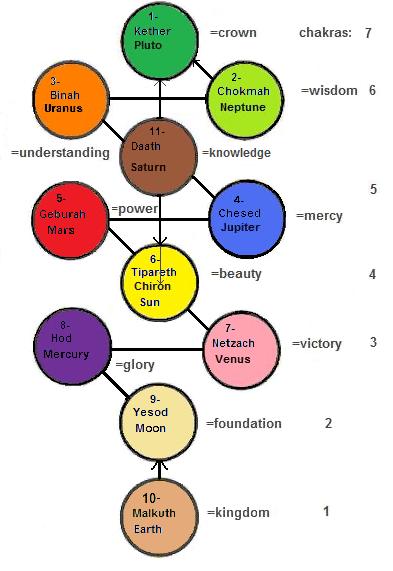
In another interesting twist, modern occultists have ALSO associated the same planets with most of the same circles on the Tree of Life, in an ascending pattern from the Earth and Moon at the bottom of the Tree to Saturn (and perhaps the outer invisible planets) at the top of the Tree. This planetary "ladder" used by occultists on the Tree is geocentric, based on the ancient view of the cosmos, so that the Sun is in the middle of the ladder at the heart chakra. In fact, of course, this place of the Sun on the Tree of Life actually represents the Earth's position. I have used this central circle to represent the highest stage, the integral. Wherever Earth is placed on the Tree, you can also put the Sun, and vice versa; depending on whether you are looking at things geocentrically or heliocentrically. Halexandria Foundation shows a Tree of Life with the planets on it (scroll down on their website a bit to see their list). An example of a more-traditional interpretation of the Tree is by BOTA (but planets are indicated only by their glyphs).
Here is a good Introduction to Kabbalah and the Tree of Life on You Tube.
Here is an article illustrating the Tree of Life with the planets indicated.
Here is an image of the Tree of Life with the symbols for the planets indicated (note how the positions of the 3 outer planets differ from both the above article, and from my Tree):
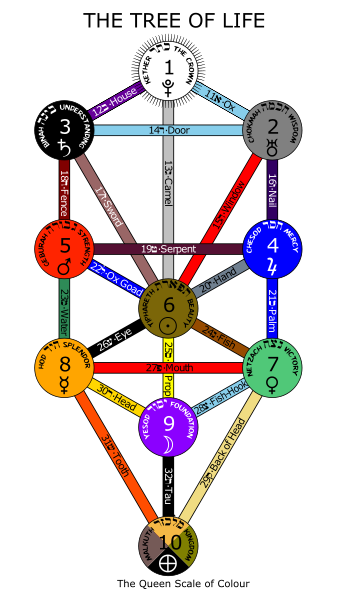
Below is a table that shows how I associate the planets with the stages (read from bottom up). As I will explain later, I perceive that cultural history is more complicated than simply a progression of one stage following another. While one predominates, the next one is rising and starts to become apparent in each stage's later years. What's more, still another meme has recently been overthrown by the current one; now channeled and guided under the dominance of the new meme to unfold its highest qualities and potentials, which it couldn't do while it was busy dominating and controlling us. I use the astrological term exalted to represent this. Of course, each newly-dominant meme also carries some of the baggage or methods of domination given us by the previous meme that is now exalted. So in the table I show how history is shaped by the dominant planetary meme, as well as by the next one rising, and by the previous one, now exalted. In addition, as we said, older memes (especially recent ones) continue to be influential, in some ways, or especially in some "more backward" places and among some groups of people. It's later "exalted" expression may also continue.
After we discovered the revolutionary planets (beginning with Uranus in 1781), the process changed a bit, as things moved more quickly. And it's harder for people to keep up, too! As the leading revolutionary trend, the "dominant planetary meme" in modern and post-modern times does not fully rule society right away, and certainly not in all places on Earth; this may take a few years. Being revolutionary and "invisible" to ordinary minds, it faces resistance from Saturn, the "status quo."
Another advantage of Planetary Dynamics is that the succession of dates resemble more closely the Fibonacci Series, the basis of the spiral in Nature. This progression applies more easily to the last 4 stages if you use only two of the dates (1781, 1977), since these 4 stages are considered two sets of "twins" or "partners." In that sense, there are still only 8 stages. The progression from Venus to Mars around -2300 also mirrors the proposed shift in astrological ages at that time from Taurus to Aries (since in astrology, Venus rules Taurus and Mars rules Aries), and that from Mars to Jupiter around 300 dovetails with the change from Aries to Pisces (co-ruled by Jupiter). Perhaps the shift to Uranus in 1781 signals the dawn of the Age of Aquarius (ruled by Uranus), although Saturn had already prepared the way as co-ruler of Aquarius.
| Begin date (approx.) | Planet | chakra & meme color | Sephiroth (#) | Meaning of Dominating Planet | Planet Exalted Under Dominant (previous meme) | Planet in Ascendant (next meme) |
| 1977 | Chiron, Sun/Earth | 4-yellow | Tipareth (6) | Integral, regression and healing, keys to growth, personal high tech, nested hierarchy, "transcend and include" all previous worldview memes | Pluto- New Age and transformational movements, the Green Party, recycling and alternative energies, consensus (Charon discovered 1978; Kuiper Belt disc. 1993) | Eris, discovered 2003-- holistic, connect to galaxy and cosmos |
| 1966 | Pluto | 7-green | Kether (1) | Ecology and Peace, All One on Earth, Eco-feminism, diversity or "fraternity," gestalt therapy etc., cultural creatives, information age, post-modern times (Uranus conj. Pluto 1966) | Neptune- Sensitivity, psychedelia, consciousness movement, search for community, etc. | Chiron- integral. Chiron disc.1977, other centaurs disc. c.1993 |
| 1846 | Neptune | 6-lemon | Chokmah (2) | Socialism, collectivism, humanitarian, "equality," romanticism, transcendentalism, mysticism, modern arts, workers, unions, socialist power (conj. Pluto 1892), modern times | Uranus- People's and Utopian Activism, industrial revolution, inventions at peak, new physics, democracy advances; Saturn still "the status quo" (e.g. old science, law) | Pluto- psychology, existentialism, bio-energetics, conservation (conj. Neptune 1892, discovered 1930) |
| 1781 | Uranus | 6-orange | Binah (3) | Democracy, Individualism, Inventions, Electricity, science of the invisible, middle class, "liberty," revolutions, early industry in Britain, idealism, proto-modern times | Saturn- constitutional law, atomic physics and chemistry | Neptune- socialism, romanticism |
| 1300 | Saturn | 5-brown | Daath (11) | Kingdoms, Science of the visible, secular state, dualism, perspective, aristocracy, early-modern times | Jupiter- revived neo-Platonic and modern philosophy, Exploration, The Reformation, "divine right" of kings | Uranus- individuals, middle class and mercantile commerce |
| 300 | Jupiter | 5-blue | Chesed (4) | Religious Rule, Church, moral laws, traditional or medieval times | Mars- chivalry, religious empires, feudalism | Saturn- state, law |
| -2300 | Mars | 5-red | Geburah (5) | Empires, war-gods, patriarchy begins, assertive self (glory and fame), metal-work, late archaic and classic age | Venus- classic visual art, commerce, the golden mean | Jupiter- religion, philosophy (Axis Age c. 500 BC) |
| -7000 | Venus | 3-pink | Netzach (7) | Agriculture, Goddess worship, fertility, towns, neolithic, archaic age | Mercury- writing, civilization | Mars- war, patriarchy, metal-work |
| -30,000 | Mercury | 3-purple | Hod (8) | Magical, tribal, animism, nomadic hunter-gatherer culture, old stone age, language | Moon- tribal identity. Moon reflects the sun's rays= Sun worship. | Venus- goddess worship, art, agriculture |
| -80,000 | The Moon | 2-beige | Yesod (9) | Instinct. Tool-making, early cultural objects | Earth-- first human societies | Mercury- magic, language |
| before -80,000 | Earth | 1-tan | Malkuth (10) | Human species homo sapiens developing | Sun: early humans | Moon: tools |
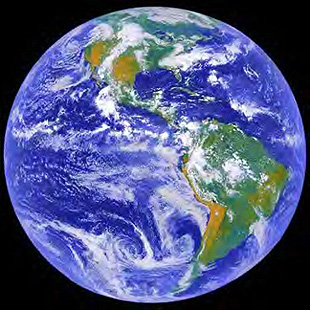 Tan, before -80,000: The Earth represents our home on which the human species began to emerge. The Moon was rising, representing invention of tools by these emerging humans. This phase represents humans that existed before our own particular line or subspecies came on the scene around -80,000 or -75,000, in South Africa, after most humans were wiped out by a climate change probably caused by a volcanic eruption in Indonesia. Even earlier was the first phase, before -250,000, that can be indicated by The Sun, now exalted in the Earth/Tan phase, which represents the first humans, going back millions of years.
Tan, before -80,000: The Earth represents our home on which the human species began to emerge. The Moon was rising, representing invention of tools by these emerging humans. This phase represents humans that existed before our own particular line or subspecies came on the scene around -80,000 or -75,000, in South Africa, after most humans were wiped out by a climate change probably caused by a volcanic eruption in Indonesia. Even earlier was the first phase, before -250,000, that can be indicated by The Sun, now exalted in the Earth/Tan phase, which represents the first humans, going back millions of years.
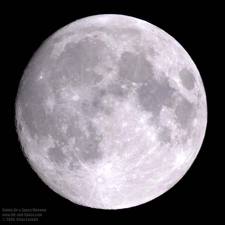 Beige, -80,000 to -30,000: The Moon is instinct and nurturing. This represents advances in tool-making, and the incubation of humanity in which we acquired our basic traits as humans, including the first culture, crafts, etc. Our line of descent began settling from Southern Africa to the rest of the world (Earth exalted) and separating into different races (Moon represents ancestry, racial identities). Mercury is in the ascendant, meaning that tribal culture and language are developing, especially in the later years of the era.
Beige, -80,000 to -30,000: The Moon is instinct and nurturing. This represents advances in tool-making, and the incubation of humanity in which we acquired our basic traits as humans, including the first culture, crafts, etc. Our line of descent began settling from Southern Africa to the rest of the world (Earth exalted) and separating into different races (Moon represents ancestry, racial identities). Mercury is in the ascendant, meaning that tribal culture and language are developing, especially in the later years of the era.
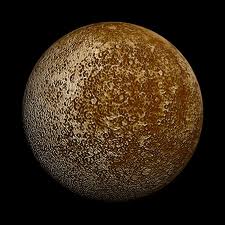 Purple, -30,000 to -7000: Mercury is knowledge, language, communication, travel, magic, and association with brethren, relatives, etc. This was the phase of nomadic hunter-gatherer tribes, cave paintings and the invention of magic through evoking the spirit of natural forces (animism = belief that each being in nature has a spirit), and influencing events with the mind. Verbal language may have fully developed in this period, as the people enacted rituals and told stories and myths of their ancestors around the campfire. The Moon was exalted, representing the expansion of family awareness into tribes. Venus rising represents the first early art in the cave paintings and in goddess sculptures, and agriculture is on the horizon or first emerging in the last years of the period.
Purple, -30,000 to -7000: Mercury is knowledge, language, communication, travel, magic, and association with brethren, relatives, etc. This was the phase of nomadic hunter-gatherer tribes, cave paintings and the invention of magic through evoking the spirit of natural forces (animism = belief that each being in nature has a spirit), and influencing events with the mind. Verbal language may have fully developed in this period, as the people enacted rituals and told stories and myths of their ancestors around the campfire. The Moon was exalted, representing the expansion of family awareness into tribes. Venus rising represents the first early art in the cave paintings and in goddess sculptures, and agriculture is on the horizon or first emerging in the last years of the period.
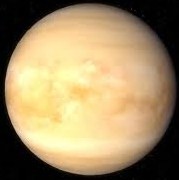 Pink, -7000 to -2300: Venus is the planet of love, beauty, values, commerce, the goddess and the fertility of Nature. This was the age when agriculture was invented and became dominant in human society. Settled life, hierarchy, division of labor, and regional trade emerged in a comparatively peaceful era. The goddess was worshipped everywhere, and the arts blossomed in the first architecture and sculpture, such as the pyramids, ziggurats and stone circles. These arts celebrated the spirituality and relationship of the Earth and Sky, the cycles of life and death, and the fertility Goddess. It was in this period that animal (and sometimes human) sacrifice was used to insure that this fertility would continue. This period is also called the new stone age (neolithic). Mercury was exalted, as the early knowledge of tribal magic developed into the first writing, inventions, astrology, and the other arts of civilization. The arrival of civilized life as we know it, circa -3000 can also be indicated by passing through the central circle (Earth) on the way to the Mars meme. Mars rising represents the first warfare and the emerging patriarchy and bronze-work in the later years of the era.
Pink, -7000 to -2300: Venus is the planet of love, beauty, values, commerce, the goddess and the fertility of Nature. This was the age when agriculture was invented and became dominant in human society. Settled life, hierarchy, division of labor, and regional trade emerged in a comparatively peaceful era. The goddess was worshipped everywhere, and the arts blossomed in the first architecture and sculpture, such as the pyramids, ziggurats and stone circles. These arts celebrated the spirituality and relationship of the Earth and Sky, the cycles of life and death, and the fertility Goddess. It was in this period that animal (and sometimes human) sacrifice was used to insure that this fertility would continue. This period is also called the new stone age (neolithic). Mercury was exalted, as the early knowledge of tribal magic developed into the first writing, inventions, astrology, and the other arts of civilization. The arrival of civilized life as we know it, circa -3000 can also be indicated by passing through the central circle (Earth) on the way to the Mars meme. Mars rising represents the first warfare and the emerging patriarchy and bronze-work in the later years of the era.
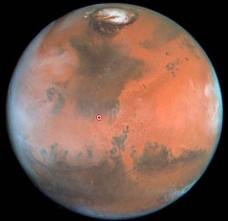 Red, -2300 to 300: Mars is the planet of war, conquest and male dominance. Beginning with Sargon, this was the age of war conducted by powerful emperors. Warrior chiefs, inspired by war-gods, conquered and ruled cities and vast territories in a series of ever more-powerful empires until they were all brought under one universal empire (Rome, or China in the Orient). Although the emperors issued edicts, these were not states in the modern sense, in which peoples shared an identity, language and law and lived within fairly-stable boundaries. This Martian kind of "state" was really just the boundaries of the latest conquest. Martian assertive individualism expressed itself in the first democratic experiments in the early classic age (c.500-100 BC), and the quest for personal fame and glory. The wars redistributed the wealth and opened trade routes, breaking through the old hierarchies of the age of agriculture. Patriarchal gods replaced worship of the goddess everywhere, brought by warrior races who swooped in to conquer existing agricultural civilizations and settlements. Mars also represents iron and the skill to conquer nature by working with metals, as the stone age yielded to that of bronze and iron. Venus was exalted in the era of classical arts (especially after -570), which was pursued within the new aggressive empires and warring city states. Ancient Greece created the first great dramas, and the Parthenon with its magnificent sculpture-- even as its leader Pericles led his people into constant wars. Egypt in the New Kingdom circa -1500-1100 became a warrior empire which conquered territory outside its usual bounds, but at the same time created its most magnificent temples such as those at Carnak and the Valley of Kings. Since conquerers use strategy to rule and administer territory, the Mars meme is also rational. People demonstrated these rational abilities in great feats of engineering like the aqueducts, especially in Greece and Rome. Jupiter rising represents the dawn of religion and philosophy which arose to guide and restrain these ambitious warriors, especially in Israel, and also in ancient Greece in the later stages of the era after -570. Jupiter and its religions had not yet reached the stage of worldly power, but its prophets and philosophers issued advice and warnings to the often-heedless warrior kings and emperors. And in the Orient, as well as in Egypt and among early Roman neo-Platonists, the rising Jupiter indicated the first mystic consciousness, which became the "perennial philosophy" available to a few initiates.
Red, -2300 to 300: Mars is the planet of war, conquest and male dominance. Beginning with Sargon, this was the age of war conducted by powerful emperors. Warrior chiefs, inspired by war-gods, conquered and ruled cities and vast territories in a series of ever more-powerful empires until they were all brought under one universal empire (Rome, or China in the Orient). Although the emperors issued edicts, these were not states in the modern sense, in which peoples shared an identity, language and law and lived within fairly-stable boundaries. This Martian kind of "state" was really just the boundaries of the latest conquest. Martian assertive individualism expressed itself in the first democratic experiments in the early classic age (c.500-100 BC), and the quest for personal fame and glory. The wars redistributed the wealth and opened trade routes, breaking through the old hierarchies of the age of agriculture. Patriarchal gods replaced worship of the goddess everywhere, brought by warrior races who swooped in to conquer existing agricultural civilizations and settlements. Mars also represents iron and the skill to conquer nature by working with metals, as the stone age yielded to that of bronze and iron. Venus was exalted in the era of classical arts (especially after -570), which was pursued within the new aggressive empires and warring city states. Ancient Greece created the first great dramas, and the Parthenon with its magnificent sculpture-- even as its leader Pericles led his people into constant wars. Egypt in the New Kingdom circa -1500-1100 became a warrior empire which conquered territory outside its usual bounds, but at the same time created its most magnificent temples such as those at Carnak and the Valley of Kings. Since conquerers use strategy to rule and administer territory, the Mars meme is also rational. People demonstrated these rational abilities in great feats of engineering like the aqueducts, especially in Greece and Rome. Jupiter rising represents the dawn of religion and philosophy which arose to guide and restrain these ambitious warriors, especially in Israel, and also in ancient Greece in the later stages of the era after -570. Jupiter and its religions had not yet reached the stage of worldly power, but its prophets and philosophers issued advice and warnings to the often-heedless warrior kings and emperors. And in the Orient, as well as in Egypt and among early Roman neo-Platonists, the rising Jupiter indicated the first mystic consciousness, which became the "perennial philosophy" available to a few initiates.
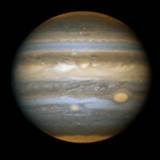 Blue, 300 to 1300: Jupiter represents the Church, philosophy, world travel and moral guidance. It is pomp, ritual, faith, and organized religion. This was the age of rule by the Church, as the Martian empires became Jovian religious ones. The Church and priesthood became dominant in society, especially in the Christian Roman Empire and its successors, and in the Islamic Empire. Here the emperor was also the chief priest (Caesaro-papism). Religious and moral law became imperial law in 300 under Constantine, and later the Popes also became emperors. Meanwhile Charlesmagne was crowned by the Pope in 800, and in 962 the Holy Roman Empire was established in Germany and Italy. Priests later became known as the first estate, the highest class in society, as bishops and powerful monastic orders extended their rule over the land. Organized religion and its cults and myths in the Age of Faith gave inspiration, confidence, prophetic hope and moral guidance to the people, and later became visible in great cathedrals, but also sometimes repressed or discouraged science and freedom of thought. Classical culture declined in the Dark Ages, often wiped out by massive migration and barbaric invasions, especially in the early years of the Jupiter/religious era. But as society gradually settled down, feudalism, hierarchy and ceremonial ritual kept people in their place in the social order. The code of chivalry represents Mars in its exalted expression, as warriors now had rules to live by, just as did the religious emperors. Although the Church was dominant, and the Pope was the first among rulers, Saturn was in the ascendant; as feudal dynasties emerged and small kingdoms expanded. The power of the state was on the horizon, and it competed with the Church for power in the later years of the era.
Blue, 300 to 1300: Jupiter represents the Church, philosophy, world travel and moral guidance. It is pomp, ritual, faith, and organized religion. This was the age of rule by the Church, as the Martian empires became Jovian religious ones. The Church and priesthood became dominant in society, especially in the Christian Roman Empire and its successors, and in the Islamic Empire. Here the emperor was also the chief priest (Caesaro-papism). Religious and moral law became imperial law in 300 under Constantine, and later the Popes also became emperors. Meanwhile Charlesmagne was crowned by the Pope in 800, and in 962 the Holy Roman Empire was established in Germany and Italy. Priests later became known as the first estate, the highest class in society, as bishops and powerful monastic orders extended their rule over the land. Organized religion and its cults and myths in the Age of Faith gave inspiration, confidence, prophetic hope and moral guidance to the people, and later became visible in great cathedrals, but also sometimes repressed or discouraged science and freedom of thought. Classical culture declined in the Dark Ages, often wiped out by massive migration and barbaric invasions, especially in the early years of the Jupiter/religious era. But as society gradually settled down, feudalism, hierarchy and ceremonial ritual kept people in their place in the social order. The code of chivalry represents Mars in its exalted expression, as warriors now had rules to live by, just as did the religious emperors. Although the Church was dominant, and the Pope was the first among rulers, Saturn was in the ascendant; as feudal dynasties emerged and small kingdoms expanded. The power of the state was on the horizon, and it competed with the Church for power in the later years of the era.
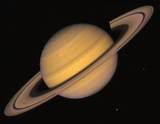 Brown, 1300 to 1781: Saturn, symbol of worldly structure, order and restriction, represents the age of kings and the power of the state and landed aristocracy, the second estate. Like during the Venus era, which I have also added to the spiral dynamic scheme, the powers-that-be depended on their control of the land and its fertility; and both eras were very hierarchical and stratified. Around 1300 powerful kings like Philip the Fair and Edward I became near-absolute rulers and asserted their domination over the Church. The Pope's exile in Avignon under Philip is the most eloquent symbol of the state's ascension. Powerful hereditary, dynastic kings became great powers: Spain, England, France, Russia, etc. Unlike the old empires, these kings ruled over states with more-stable territories often populated by people with a developing common culture and language. The kings made the law and held the allegiance of the people, and their power was on display in elegant palaces. Just as kings, guided by law and sanctioned by God, ruled over the people and the land, so emerging science (Roger Bacon, William of Occam, c.1300) gave birth to the new technology which ruled over visible Nature so that people could use it for their own ends. Seeing was believing. The artists of the Renaissance invented perspective (1420), giving us a humanist, structured view of the world as a landscape over which we could travel and conquer. They also inspired the world explorers and conquerers (Columbus, 1492), which led to advances in navigation, astronomy and physics (Copernicus c.1540, Galileo c.1600, Newton c.1680) in the scientific revolution. The new science (e.g. Descartes, 1637) split the world into the human spirit dominating an alien physical world, which empowered it to throw off the restraints of religion. Confrontation with reality (e.g. the black plague, 1348), and the subsequent questioning of Faith in the increasingly-secular age of kings, was reflected in the tragedies of Shakespeare (1600). Meanwhile Jupiter was exalted beyond religious dogma into a revival of philosophy (Renaissance neo-platonism and humanism), as well as in the spread of civilization and religion around the globe (Jupiter means wide travel and exploration) through colonization by the kings and explorers. The Reformation purified the practices and doctrines of the Christian Church. As commerce expanded, the bourgeois middle class merchants, accountants, and mercantile powers were in the ascendant (Uranus rising), and individual consciousness was rising (Renaissance inspired seekers of fame and fortune). The scientific revolution encouraged increasing questioning of authority in politics as well as in religion, at least in the later years of the era.
Brown, 1300 to 1781: Saturn, symbol of worldly structure, order and restriction, represents the age of kings and the power of the state and landed aristocracy, the second estate. Like during the Venus era, which I have also added to the spiral dynamic scheme, the powers-that-be depended on their control of the land and its fertility; and both eras were very hierarchical and stratified. Around 1300 powerful kings like Philip the Fair and Edward I became near-absolute rulers and asserted their domination over the Church. The Pope's exile in Avignon under Philip is the most eloquent symbol of the state's ascension. Powerful hereditary, dynastic kings became great powers: Spain, England, France, Russia, etc. Unlike the old empires, these kings ruled over states with more-stable territories often populated by people with a developing common culture and language. The kings made the law and held the allegiance of the people, and their power was on display in elegant palaces. Just as kings, guided by law and sanctioned by God, ruled over the people and the land, so emerging science (Roger Bacon, William of Occam, c.1300) gave birth to the new technology which ruled over visible Nature so that people could use it for their own ends. Seeing was believing. The artists of the Renaissance invented perspective (1420), giving us a humanist, structured view of the world as a landscape over which we could travel and conquer. They also inspired the world explorers and conquerers (Columbus, 1492), which led to advances in navigation, astronomy and physics (Copernicus c.1540, Galileo c.1600, Newton c.1680) in the scientific revolution. The new science (e.g. Descartes, 1637) split the world into the human spirit dominating an alien physical world, which empowered it to throw off the restraints of religion. Confrontation with reality (e.g. the black plague, 1348), and the subsequent questioning of Faith in the increasingly-secular age of kings, was reflected in the tragedies of Shakespeare (1600). Meanwhile Jupiter was exalted beyond religious dogma into a revival of philosophy (Renaissance neo-platonism and humanism), as well as in the spread of civilization and religion around the globe (Jupiter means wide travel and exploration) through colonization by the kings and explorers. The Reformation purified the practices and doctrines of the Christian Church. As commerce expanded, the bourgeois middle class merchants, accountants, and mercantile powers were in the ascendant (Uranus rising), and individual consciousness was rising (Renaissance inspired seekers of fame and fortune). The scientific revolution encouraged increasing questioning of authority in politics as well as in religion, at least in the later years of the era.
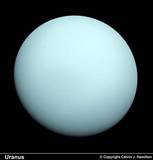 Orange, 1781 to 1846: Uranus, symbol of invention and revolution, represents the age of democratic revolution (Uranus discovered, 1781). Inspired in part by the Americans, who achieved independence from Britain in 1781, the French in their Revolution overthrew their kings and aristocracy (1789-92) and formed a nation ruled by its people. Patriotism was established. Then the new "emperor" Napoleon spread democratic law codes throughout Europe. Much like what happened during the earlier yang Mars era, the revolutions of Uranus broke through class hierarchies and spread the wealth around. The industrial revolution "took off" in 1781, especially in England, as the Middle Class (the third estate) became dominant and aristocratic barriers to commerce were increasingly removed (feudalism dissolved, 1789; corn laws finally repealed, 1846). Adam Smith described the wealth of nations based on laissez-faire (free enterprise). Inventions and discoveries suddenly opened invisible realms to our knowledge, corresponding to Uranus as the first planet discovered that is normally invisible to the naked eye (ultra-violet light, electricity and batteries discovered c.1780; magnetic generators, railroads c. 1830). Going beyond the visible also expressed itself in transcendental idealist philosophy (Kant, 1781, Hegel 1807), showing that the Uranus meme is not just a science meme, like the orange achievement meme of Spiral Dynamics. In fact, science under Uranus was actually breaking down Saturnian structures in thought as well as in politics in the 19th century, eventually leading to modern physics that explains the invisible realms. Uranus also opened the age of the romantic rebel, in all its many aspects, along with its partner Neptune that came along shortly. But the true original symbol of empirical, physical science of the visible, and also of the secular state, Saturn, became exalted in this era, as scientific discovery advanced into the invisible. At the same time, royal edicts and common law became codified in the first constitutions that established justice and balance of power. With Saturn exalted, the state became (potentially at least) a protector of human rights (Bill of Rights, 1791; Rights of Man and Citizen, 1789), as well as continuing to be an instrument of wealthy and powerful elites. Meanwhile already in the French Revolution (Robespierre, 1793, Babeuf, 1796) workers and peasants began demanding freedom from wealthy bourgeois industrial bosses (Neptune rising). By the end of the era new socialist utopias were being dreamed, proposed and experimented with. The neo-classic art and music of the Uranus era (gallant style) gradually expanded into romanticism, including the worship of Nature and the quest of the exotic (Wordsworth, 1798, Beethoven 9th Symphony 1823).
Orange, 1781 to 1846: Uranus, symbol of invention and revolution, represents the age of democratic revolution (Uranus discovered, 1781). Inspired in part by the Americans, who achieved independence from Britain in 1781, the French in their Revolution overthrew their kings and aristocracy (1789-92) and formed a nation ruled by its people. Patriotism was established. Then the new "emperor" Napoleon spread democratic law codes throughout Europe. Much like what happened during the earlier yang Mars era, the revolutions of Uranus broke through class hierarchies and spread the wealth around. The industrial revolution "took off" in 1781, especially in England, as the Middle Class (the third estate) became dominant and aristocratic barriers to commerce were increasingly removed (feudalism dissolved, 1789; corn laws finally repealed, 1846). Adam Smith described the wealth of nations based on laissez-faire (free enterprise). Inventions and discoveries suddenly opened invisible realms to our knowledge, corresponding to Uranus as the first planet discovered that is normally invisible to the naked eye (ultra-violet light, electricity and batteries discovered c.1780; magnetic generators, railroads c. 1830). Going beyond the visible also expressed itself in transcendental idealist philosophy (Kant, 1781, Hegel 1807), showing that the Uranus meme is not just a science meme, like the orange achievement meme of Spiral Dynamics. In fact, science under Uranus was actually breaking down Saturnian structures in thought as well as in politics in the 19th century, eventually leading to modern physics that explains the invisible realms. Uranus also opened the age of the romantic rebel, in all its many aspects, along with its partner Neptune that came along shortly. But the true original symbol of empirical, physical science of the visible, and also of the secular state, Saturn, became exalted in this era, as scientific discovery advanced into the invisible. At the same time, royal edicts and common law became codified in the first constitutions that established justice and balance of power. With Saturn exalted, the state became (potentially at least) a protector of human rights (Bill of Rights, 1791; Rights of Man and Citizen, 1789), as well as continuing to be an instrument of wealthy and powerful elites. Meanwhile already in the French Revolution (Robespierre, 1793, Babeuf, 1796) workers and peasants began demanding freedom from wealthy bourgeois industrial bosses (Neptune rising). By the end of the era new socialist utopias were being dreamed, proposed and experimented with. The neo-classic art and music of the Uranus era (gallant style) gradually expanded into romanticism, including the worship of Nature and the quest of the exotic (Wordsworth, 1798, Beethoven 9th Symphony 1823).
 Lemon, 1846 to 1966: Neptune, symbol of collective consciousness and power, dissolving boundaries, and mystical vision (Neptune discovered, 1846), represents the age of socialism. Industry expanded to many nations and people migrated across the globe. New Thought religions and new mystic philosophies emerged (spiritualism, 1850s; theosophy, 1890s). Neptune can be considered Uranus' partner-- two shorter phases on the same 6th level on the "Tree of Life" of planetary dynamics-- thus often ruling together. But after 1846, the Neptune meme gained power; attaining dominance by the 1890s and 1900s (Neptune conj. Pluto c.1892). By then, free enterprise/democracy (Uranus) and socialism and the welfare state (Neptune) were the ideologies of our political parties, and later competed for world power in the Cold War (Neptune square Uranus, 1950s). Neptune represents rising working class power, which I call the fourth estate (Communist Manifesto, 1848; labor unions, socialist parties achieve power in 1890s-1900s), but also increasing identification of peoples with their race (nationalism, racism, fascism, Nazis, KKK, civil rights movement, etc.), and in general submersion or sacrifice of the individual into the mass collective society. Humanitarian activism became part of our culture (Florence Nightengale, Clara Barton). Romantic art and music expanded into rich and lush sights and sounds, and transcendentalism, nature worship reached a high expression (Emerson, Thoreau, Ruskin, c.1840s-50s). Uranus was exalted in this era, as democracy expanded and revolutionaries became the voice of the common people, not just the middle class. Not only did industry become global, instead of confined to England, but inventions reached a peak (c.1880s-1910s) and the benefits of technology were extended to all. Science entered a new revolution, as the discoveries of the Uranus era (light, electricity) opened up the domain of modern physics, which is leading gradually to a new science compatible with mysticism; although scientific materialism still predominates (Saturn still powerful as "the status quo"). Meanwhile, as socialist group-culture and industry alienated people from Nature in a dis-enchanted world, mailaise grew, and soul-searching began among lonely individual seekers within the mass of humanity (Pluto rising). Out of this came depth psychology, existentialism and modern art in the later years of the Neptune era (starting with Neptune conj. Pluto, 1890s). The holocaust of the world wars and nuclear weapons demonstrated the ultimate futility of war and nationalist racism (Pluto discovered, 1930).
Lemon, 1846 to 1966: Neptune, symbol of collective consciousness and power, dissolving boundaries, and mystical vision (Neptune discovered, 1846), represents the age of socialism. Industry expanded to many nations and people migrated across the globe. New Thought religions and new mystic philosophies emerged (spiritualism, 1850s; theosophy, 1890s). Neptune can be considered Uranus' partner-- two shorter phases on the same 6th level on the "Tree of Life" of planetary dynamics-- thus often ruling together. But after 1846, the Neptune meme gained power; attaining dominance by the 1890s and 1900s (Neptune conj. Pluto c.1892). By then, free enterprise/democracy (Uranus) and socialism and the welfare state (Neptune) were the ideologies of our political parties, and later competed for world power in the Cold War (Neptune square Uranus, 1950s). Neptune represents rising working class power, which I call the fourth estate (Communist Manifesto, 1848; labor unions, socialist parties achieve power in 1890s-1900s), but also increasing identification of peoples with their race (nationalism, racism, fascism, Nazis, KKK, civil rights movement, etc.), and in general submersion or sacrifice of the individual into the mass collective society. Humanitarian activism became part of our culture (Florence Nightengale, Clara Barton). Romantic art and music expanded into rich and lush sights and sounds, and transcendentalism, nature worship reached a high expression (Emerson, Thoreau, Ruskin, c.1840s-50s). Uranus was exalted in this era, as democracy expanded and revolutionaries became the voice of the common people, not just the middle class. Not only did industry become global, instead of confined to England, but inventions reached a peak (c.1880s-1910s) and the benefits of technology were extended to all. Science entered a new revolution, as the discoveries of the Uranus era (light, electricity) opened up the domain of modern physics, which is leading gradually to a new science compatible with mysticism; although scientific materialism still predominates (Saturn still powerful as "the status quo"). Meanwhile, as socialist group-culture and industry alienated people from Nature in a dis-enchanted world, mailaise grew, and soul-searching began among lonely individual seekers within the mass of humanity (Pluto rising). Out of this came depth psychology, existentialism and modern art in the later years of the Neptune era (starting with Neptune conj. Pluto, 1890s). The holocaust of the world wars and nuclear weapons demonstrated the ultimate futility of war and nationalist racism (Pluto discovered, 1930).
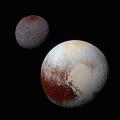 Green, 1966-: That brings us to our own era, the age of Pluto (conjunct Uranus, 1966; Charon discovered 1978). I date the Pluto era later than its discovery in 1930, because it was not until the 1960s and 70s that we began to fully see Pluto's physical characteristics. For the first time, in this Pluto era, a great peace movement eventually stopped a major war conducted by the world's most-powerful state (American-Vietnam War 1965-1975). From now on, war is increasingly seen as out of date, partly because of the danger to all life posed by nuclear weapons (said by astrologers to be linked to Pluto), but also because we know through our common peril that we are all one people on one common Earth. This means respect for diversity instead of domination. Pluto represents life and death choices. Being now conscious as never before of the growing power of humans to end all life on Earth (Earth Day, 1970), green ideas have become a growing power in society, and recycling and sustainable energy are now top priorities. The greenpeace movement and environmentalism is beginning to dominate both politics and economics in the Pluto era, and the Green Party is a new force (Green Party in governing coalitions in Europe in 1980s; Nader spoiled US elections, 2000). Like the other revolutionary memes, Uranus/democracy and Neptune/socialism, it will take time for the Pluto Green meme to be fully dominant politically (Uranus opposite Pluto, late 2040s). Global warming is already requiring advanced post-industrial states to implement new energy policies (Carter, USA 1977, China/Europe, 2000s). Meanwhile the women's movement and eco-feminism is displacing patriarchal power in economics and politics. Absolutes are denied in post-modern times.
Green, 1966-: That brings us to our own era, the age of Pluto (conjunct Uranus, 1966; Charon discovered 1978). I date the Pluto era later than its discovery in 1930, because it was not until the 1960s and 70s that we began to fully see Pluto's physical characteristics. For the first time, in this Pluto era, a great peace movement eventually stopped a major war conducted by the world's most-powerful state (American-Vietnam War 1965-1975). From now on, war is increasingly seen as out of date, partly because of the danger to all life posed by nuclear weapons (said by astrologers to be linked to Pluto), but also because we know through our common peril that we are all one people on one common Earth. This means respect for diversity instead of domination. Pluto represents life and death choices. Being now conscious as never before of the growing power of humans to end all life on Earth (Earth Day, 1970), green ideas have become a growing power in society, and recycling and sustainable energy are now top priorities. The greenpeace movement and environmentalism is beginning to dominate both politics and economics in the Pluto era, and the Green Party is a new force (Green Party in governing coalitions in Europe in 1980s; Nader spoiled US elections, 2000). Like the other revolutionary memes, Uranus/democracy and Neptune/socialism, it will take time for the Pluto Green meme to be fully dominant politically (Uranus opposite Pluto, late 2040s). Global warming is already requiring advanced post-industrial states to implement new energy policies (Carter, USA 1977, China/Europe, 2000s). Meanwhile the women's movement and eco-feminism is displacing patriarchal power in economics and politics. Absolutes are denied in post-modern times.
It is important to emphasize that Green politics is not just an extension of communitarian socialism (Lemon); its values bring back democratic reform, local economics and smaller institutions. While proclaiming that we are all one people on one planet, it also synthesizes the two previous revolutions, the individual and the collective, and thus is proto-integral (Chiron rising). It reclaims the value of the person from the runaway dehumanizing forces of the industrial era. Meanwhile cultural creatives and New Age movements reveal the Spirit to the lonely existential seekers of the previous era (represented by Pluto rising during the Neptune era), as the world is being gradually re-enchanted and religions of Nature are being revived. Science and mysticism are being combined into a "new paradigm" beyond mechanist thought. The counterculture (LSD, 1966) spread this new awakening through psychedelics (Neptune exalted), and the new ambient music expands romanticism. Consciousness of world unity now transcends boundaries of race, nation, religion and gender ("Imagine" by John Lennon, 1971; "We Are the World," 1984; world prayer, 1986; harmonic convergence, 1987). Mysticism and the perennial philosophy have revived again since the 1960s among people in the West, since Neptune is now exalted under Pluto.
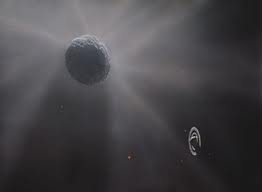 Yellow, 1977-: Just as Pluto represents all these new trends emerging since the 1960s, its historical partner Chiron, the first of the many similar Centaurs to be discovered orbiting between Jupiter and Neptune, has added new dimensions to them. The Chiron or Yellow meme emphasizes the trend toward integral consciousness begun under the Green meme, and is its partner. The new mysticism (Neptune exalted in Pluto era) thus has become not only about oneness, but about individual holographic wholes within wholes. Just when Chiron was discovered in 1977, information technology put new creative and political power in peoples' hands (first video games; apple computer founded 1977). 1977 is coincidentally the date of the first publication of a book by integral philosopher Ken Wilber. Practical techniques of personal growth, holistic health and spiritual healing have developed in the burgeoning New Age Movement (it acquired this name and identity around 1977). The Green Party was founded at about this same time, giving the green movements of the 1960s a specific political platform. The small rocky comet-asteroid Chiron's symbol of The Key shows that its position and movement between the visible and invisible planets, along with that of the other centaurs, provides its significance for us. They indicate new tools to help us access these higher outer-planet realms of power and inspiration, and at the same time help us and remind us to manifest this in our world and to integrate this new vision with the past cultures from which we have emerged. Our normal time routines and our usual ways may be pierced at times by the Centaurs so that we may make adjustments between the old and the new, and between the physical and the spiritual.
Yellow, 1977-: Just as Pluto represents all these new trends emerging since the 1960s, its historical partner Chiron, the first of the many similar Centaurs to be discovered orbiting between Jupiter and Neptune, has added new dimensions to them. The Chiron or Yellow meme emphasizes the trend toward integral consciousness begun under the Green meme, and is its partner. The new mysticism (Neptune exalted in Pluto era) thus has become not only about oneness, but about individual holographic wholes within wholes. Just when Chiron was discovered in 1977, information technology put new creative and political power in peoples' hands (first video games; apple computer founded 1977). 1977 is coincidentally the date of the first publication of a book by integral philosopher Ken Wilber. Practical techniques of personal growth, holistic health and spiritual healing have developed in the burgeoning New Age Movement (it acquired this name and identity around 1977). The Green Party was founded at about this same time, giving the green movements of the 1960s a specific political platform. The small rocky comet-asteroid Chiron's symbol of The Key shows that its position and movement between the visible and invisible planets, along with that of the other centaurs, provides its significance for us. They indicate new tools to help us access these higher outer-planet realms of power and inspiration, and at the same time help us and remind us to manifest this in our world and to integrate this new vision with the past cultures from which we have emerged. Our normal time routines and our usual ways may be pierced at times by the Centaurs so that we may make adjustments between the old and the new, and between the physical and the spiritual.
Pluto is exalted in the yellow Chiron meme. Notice again that Pluto's moon Charon was discovered at the same time as Chiron. In effect then, the updated version of the Green meme, is now also part of the integral meme. As Pluto's Moon was discovered, so was its intense, mutual gravitationally-locked interrelationship to Pluto. Thus Pluto became an eloquent symbol of synthesis and interdependence, like the idea of ecology itself. Both Chiron and Pluto-Charon are also symbols of the emerging information age. Integrated circuits, invented in the mid-1960s (date of the Pluto meme's ascendancy), got ever-smaller and yet more powerful in subsequent years as personal computers and devices were developed, just as Pluto got smaller in our perception and new smaller objects were discovered. Small is beautiful, it appears; and more-powerful too! Dual planet Pluto-Charon became the symbol of binary systems, the basis of all computer language and circuitry. The crowning "cloud" of the Kuiper Belt became a symbol of the world wide web, invented in the year of the Belt's discovery.
At the same time, the new Green movements sparked a backlash, which as of 2017 has held politics in a regressive stalemate for decades (Margaret Thatcher in Britain 1979, Ronald Reagan elected US president 1980; Contract with America 1994, Tea Party 2010, Donald Trump 2016), taking us backward to earlier memes (like Saturn's materialism, and perhaps especially a false version of the Orange free-market, individualist meme), which in fact institutes an oppressive Saturnian corporate oligarchy. Regression to Jupiter represents the rise of the fundamentalist religious right and jihadist Islamic terrorism since 1978-79, while Mars represents the new imperialism under George W. Bush in 2003 (Project for a New American Century), and the ethnic strife and psychologically-regressed male aggression personified by Donald Trump (2017). Such regression may be unprecedented. Some also ask whether the New Age and sixties-style culture might regress us back to "pre-rational" stages that hook us on fantasy and "conspiracy theory" (begun 1966 by Mark Lane), instead of advancing us to higher non-rational ones. Under the Chiron great regression, the Green meme is derided as "woke", as enforcement of diversity sometimes becomes too extreme and turns some people off and elicits extreme regression toward hierarchy in a reactionary reply.
Could all this regression have a larger purpose? As we become disillusioned with "progress" under the 3 outer modern invisible planets that disenchants and pollutes the world, and destroys the individual and hierarchy too, perhaps we can "regress" to reclaim and integrate for the first time the best of all the values from all preceeding "memes" in planetary/spiral dynamics, once we have healed ourselves from their worst aspects being released and revealed to us today. The polarized pair of Pluto-Charon may represent the increasing polarization of politics, as the Reagan-Gingrich-Religious Right backlash unfolded. The new integral or Chiron meme also reminds those of us influenced by the All One People Pluto/Green/post-modern meme that all people and all things are not entirely equal, and that we value excellence and quality. As our perspective widens, perhaps a theory of everything, in culture and society as well as in physics, is emerging today under Pluto/Charon, Chiron, and their many Kuiper belt and centaur companions discovered since the 1990s. The solar system is larger and more diverse and multi-faceted than we thought, and so is life and the universe. This may also indicate our age of space exploration and increasing alien visitations (Eris rising).
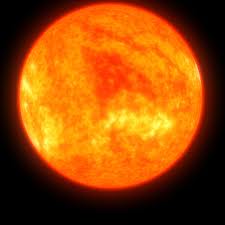 I put the yellow Chiron/centaur stage down below Pluto on the Tree, on the path from Kether down to the central circle, to represent the fact that in many ways it is taking us below Neptune (socialism, etc.) again. The "temporary" status of Chiron and the centaurs, cast downward from the Kuiper belt by Neptune and Pluto, may represent the transitory nature of these regressive movements that began when Chiron ("the wounded healer") was discovered in 1977, or it may indicate the periodic need to take the "downward" current as well as the upward one on the planetary ladder, in order to find integration and healing. When this integration is finally found, it is represented by The Sun (and its color yellow), traditionally placed at the heart chakra in Tipareth by kabbalists, and this is also The Earth. With the discovery of Chiron, we began the journey to integration; the Sun represents a future time when we achieve it. Turquoise then represents a future "holistic" stage (Eris) when we can move forward again up to Kether and beyond. The vast new discoveries in the Kuiper belt (starting with Pluto in 1930) and of the centaurs (beginning with Chiron in 1977) is a momentous opportunity to connect our mind (at the top of the Tree) and heart (at the center) in a new higher consciousness guiding us from above, both as individuals and as a new planetary civilization. We are developing this heart/spirit connection, represented by the line with arrows connecting the heart and crown chakras in our new planetary Tree of Life diagram above.
I put the yellow Chiron/centaur stage down below Pluto on the Tree, on the path from Kether down to the central circle, to represent the fact that in many ways it is taking us below Neptune (socialism, etc.) again. The "temporary" status of Chiron and the centaurs, cast downward from the Kuiper belt by Neptune and Pluto, may represent the transitory nature of these regressive movements that began when Chiron ("the wounded healer") was discovered in 1977, or it may indicate the periodic need to take the "downward" current as well as the upward one on the planetary ladder, in order to find integration and healing. When this integration is finally found, it is represented by The Sun (and its color yellow), traditionally placed at the heart chakra in Tipareth by kabbalists, and this is also The Earth. With the discovery of Chiron, we began the journey to integration; the Sun represents a future time when we achieve it. Turquoise then represents a future "holistic" stage (Eris) when we can move forward again up to Kether and beyond. The vast new discoveries in the Kuiper belt (starting with Pluto in 1930) and of the centaurs (beginning with Chiron in 1977) is a momentous opportunity to connect our mind (at the top of the Tree) and heart (at the center) in a new higher consciousness guiding us from above, both as individuals and as a new planetary civilization. We are developing this heart/spirit connection, represented by the line with arrows connecting the heart and crown chakras in our new planetary Tree of Life diagram above.
This line goes both ways, just like Spiral Dynamics and the chakra currents. The centaurs are moving us inward toward the Earth and the Sun at the heart chakra, and the outer objects beyond Neptune are leading us outward toward the heart of the galaxy. This shows how in our new integral/holistic paradigm, we are learning to go inward and outward at once. We are learning that we effect the cosmos, as fully as it affects us. As Alan Watts said, "the whole universe depends on you, as much as you depend on it." Pluto and its Moon Charon, in their tight interrelationship, also represent interdependence. Pluto/Charon is meditation and inner spiritual power, in which active and passive/individual and whole blend as one; just as Pluto acts upon Charon, yet also is acted upon by Charon, and vice-versa. This is why Pluto-Charon also represents ecology, a link which was realized by this author 6 years before Charon was discovered, and one year after the first Earth Day.
Pluto-Charon may be the most significant planet of any size in our solar system. It truly merits its place at the top of the Tree of Life. Although there are other dual or binary planets in the Kuiper Belt, I have as yet heard of none with so close a relationship as Pluto/Charon, and in any case, none will likely be found close to Pluto in size or more significant than Pluto in its orbit. What are the chances that such a tightly-dual planet could even exist? As well as ecology, it represents synchronicity and synthesis-- and also all the new findings in physics. The most amazing aspect of quantum theory, for example, is the fact that quanta are connected no matter how distant and out-of-contact they are. This connection at a "spooky distance" between spinning quanta is called entanglement, which Pluto and Charon exemplify by their completely-entangled connection to each other (though not literally, since their "entanglement" is caused by gravity, not quantum mechanics). Quantum theory, developed just as Pluto was discovered around 1930, came into sharper focus when this Bell Theorem was developed in the 1960s. These were signs of the emerging Green meme, and its nature as inter-relationship. A year or two after 1977, String Theory (begun in the late 1960s) came together and became popular, reducing quantum "particles" into massless "strands" of energy resonating like music. These strings are conceived, in among other ways, as shifting back and forth and turning around, just as if they were very-miniature spirals or chakra currents. Spiral galaxies, spiral chakras, and spiral strings; as above, so below.
Some people would rather not crown "tiny" Pluto at the top of the Tree of Life, preferring to tie it instead to shadowy Daath. But the outer 3 invisible planets Uranus, Neptune and Pluto remain a transcendental trinity, just like the Mind and "personhood" of God represented by the highest 3 circles on the Tree. Just as the whole universe started from a concentrated point, size doesn't count where the symbol of the source of creation (Kether) is concerned. And the power of Pluto is made crystal clear by how it dispenses the fortunes of civilization, dealing life and death to great empires and armies on Earth as it moves in its great cycles, as well as sending centaurs down toward the Earth on a journey from the depths. Pluto, with its concentrated, synthetic, entangled, constant relationship to its moon Charon that gives it such concentrated power and focus, truly is the Lord of the outer solar system. Therefore I put Pluto on the Tree in accordance with the natural planetary progression upward and outward, on top of the Tree at Kether (which means crown), just where it should be! The entire Kuiper Belt is also indicated by Pluto's place on the Tree, and it also represents the great "diversity" of the green meme of All One People. It is a great symbol of a "crown" that surrounds and encircles the edge of the solar system. Interestingly, according to wikipedia, "The guidelines established by the IAU demand that classical KBOs be given names of mythological beings associated with creation." Similarly, wherever Chiron is shown, representing the discovery of the Integral yellow meme, all the centaurs are indicated too. The Sun itself is the symbol of full integration which we find within our own hearts, and it is also connected to the crown chakra.
The small planets that extend beyond the Kuiper Belt crown, including Eris, are represented by the "pre-Tree, indescribable" circles said to lie above the Tree, representing the holistic meme now rising which potentially connects us with the spirit throughout the greater cosmos. Philip Brown in his article on Eris writes that Eris may represent "the uninvited (by patriarchal culture) true strength and power of women," and "wholeness, the self, and creativity", among other things. Eris moves far outside the plane of the other planets, and far beyond the Kuiper Belt, suggesting that it can connect us with what is outside, uninvited, and far away. Now that we know all the planets, allowing us to get all of our chakras and planets working together, we may be ready to join a larger evolution already going on among the ETs in our galaxy, whose stages are represented by much greater symbols.
Eris
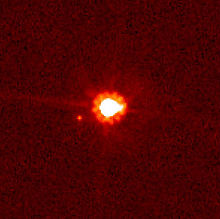
Some notes on the planetary dynamic stages, and how they match the sephiroth and planets on the Tree of Life:
Earth, our home and center (tan) = Malkuth, which represents the Earth on the Tree; the place where we reside; the greater Self or Kingdom from which we arise.
Moon, the nurturer (beige) = Yesod, symbol of the Garden of Eden that nurtures life, as well as instinct and dreams in the subconscious, matching the instinctive phase in Spiral Dynamics.
Mercury, the messenger (purple) = Hod, symbol of magic and thought, representing that tribal age of magic when myths, language and symbols arose.
Venus, goddess of beauty and love (pink) = Netzach, symbol of endurance (agriculture), and of the emotional attraction of the senses. The earth's fertility, worshipped as the goddess.
Mars, god of war (red) = Geburah, symbol of severity, strength, power and judgement, matching the age of wars and the power of empires, and the development of the aggressive ego.
Jupiter, good fortune and guidance (blue) = Chesed, symbol of mercy and the flowing goodness and bounty of the divine power, worshipped in the church of traditional religion.
Saturn, limits and structure (brown) = Daath, symbol of hidden knowledge, shadow of the crown, and the shadow sides of life. This refers to the fact that esoteric knowledge was increasingly kept hidden while the limited, structuring knowledge of science developed during the Age of Kings. We are subject to our shadows while we still only have access to the Saturn level of limited structures and fate. Once we cross this "rainbow bridge," greater and freer awareness of the transcendent may be unveiled.
Uranus, individualism, invention, and revolution (orange) = Binah, the symbol of form creation in the Mind of God; rational archetypes, the left brain, technology, discovery, transcendental idealism. God's higher energies are becoming accessible to us in modern times as we reach these higher spheres above the abyss. The phase of liberation and the ideal of progress.
Neptune, mystical and socialist (lemon) = Chokmah, symbol of the creative flow of energy in the Mind of God, and the right brain, intuition, imagination, romanticism, collective consciousness. We contact this level of the Tree in mystical experience and compassion, which Neptune represents.
Pluto/Kuiper Belt, transformation, ecology (green) = Kether, symbol of the source and the crown, like the thousand-fold, diverse Kuiper Belt crowning our solar system, and the origin of the centaurs. The crown chakra is known as sahasrara, meaning thousand-fold. Pluto and the Kuiper Belt is diversity and ecology, and Kether is the unity of God and the One which brings all humanity together as One planet in the All-One-People meme of the Pluto era.
Chiron/Centaurs, the wounded healers = the line descending to Tipareth, like the centaurs pulled downward below Neptune and Pluto; the line connecting back down to the heart, the mythical "return" in the hero's journey, through healing and regression, leading to:
Sun, the soul and center from which life flows (yellow) = Tipareth, symbol of integration, balance, the heart, inclusiveness, competent leadership, becoming a radiant soul center, and "transcending" back up to:
Eris/Outer or Scattered Disc Objects (turquoise) = Ain Soph Aur and the other invisible sephiroth; holistic, leading out to the galaxy, the ethers, and Spirit the infinite Light.
We can see Pluto/Kuiper Belt, Chiron/Centaurs, and Eris/Outer Objects, much like Uranus/rahu, Neptune/ketu, and Pluto without the Belt, as another trinity, representing the crown, the current running down from the crown and above, and the current running up to the crown and beyond; a cosmic kundalini.
We can also associate these planetary phases with some of the tarot trump cards, particularly the worldly rulers:
If this is so, then in the 1960s and 70s we became The Fool (trump card #0 in the tarot series) and began our collective quest through the counter-cultural creative and new age movements, indeed seeming like fools as we started. But we have heard the new call together, and thus have begun the journey. It is now up to more of the people to recognize this. Since new technologies and holistic techniques came to us at Chiron's and Charon's discovery in 1977, we have become the Magician (trump #1), empowered by personal computers, smart phones, crystal wands and herbal remedies. If the new green movement reaches its climax in the 2040s, as I predict, that could indicate a Priestess stage (trump #2) in which our emerging feminine, esoteric and intuitive consciousness starts to fully blossom. Spiritual guides may appear then in greater abundance to help us move down the collective path to manifest God on Earth in a wiser way.
Even so, as we pursue a collective spiritual quest, each person's quest remains personal, and thus is represented by the climb up the paths of the Tree, from the bottom up, just as God emanates creative energy down the Tree to us through the circles from the crown. This is symbolized by the tarot cards beginning with the Fool and Magician placed on paths at the bottom of the Tree, and then moving up through the trump card sequence. See The Tarot Journey and Bach Chakras Tarot to follow this quest.
We can accept that people are at different stages on the planetary or spiral dynamic, in America or in other cultures, and work with them on their level. We can also see how we might have "regressed," if we get stuck in unhealthy aspects of one of these memes that lie below the integral one, when we could, if made aware, release ourselves from their limitations and move up, transcending but still including the proper lessons from each meme in a higher synthesis.
We noted above that Mercury's place on the left side of the Tree of Life does not fit the description of the purple meme in Spiral Dynamics as group-oriented. Spiral Dynamics proposes that the stages alternate between assertiveness and bonding, but this is not entirely correct. Each stage also involves its particular way of bonding, generally in ever-larger groups:
Beige/Moon: extended families
Purple/Mercury: tribes
Pink/Venus: cities, towns, villages
Red/Mars: empires
Blue/Jupiter: church, religions
Brown/Saturn: dynastic states
Orange/Uranus: nations of free citizens, la patrie
Lemon/Neptune: economic class, workers collectives
Green/Pluto: all one people in one earth ecology
Yellow/Chiron and Sun: all the stages together in one integral whole
Turquoise/Eris: contact with the galaxy
What do the asteroids between Mars and Jupiter represent? Several interpretations are possible. They are often said to represent goddesses. The thousands of objects in the Asteroid Belt (which in total mass only amount to 4% of The Moon's) could represent the diversity of the Hellenistic Age, late in the Mars stage, especially in the Roman Empire before Christianity became dominant in the Piscean Age ruled by Jupiter. This era was similar to our own, because people were mixing together and losing their separate tribal and imperial identities. Hermetic philosophy developed in this period because a great cross-fertilization of ideas could take place. But just as the asteroids "were too strongly perturbed by Jupiter's gravity to form a planet" acc. to wikipedia, so the emerging power of the Jupiter meme under Christianity kept the many other cults and philosophies of the time from surviving or having much influence in the following era. The asteroids are a modern discovery, though; unknown in Hellenistic times. The largest asteroid Ceres, discovered in 1801, is now considered a dwarf planet and is larger than all the other asteroids put together. It represents the nourishing qualities of Nature, although some say it can be too fanatical. As we discovered the asteroids in the 19th century, we also discovered true history and also simultaneously the preoccupation with romanticizing the past, especially perhaps the times before Christianity became dominant under Jupiter in circa 300 AD. Pluto represents the similar diversity in our own time, just as Ceres and the asteroid belt did during the Hellenistic Era. Pluto brings us up into the Kuiper Belt, also full of thousands of objects representing another time of disintegration, today, which could lead us toward a New Age and beyond, as we move out beyond the solar system past Pluto and Eris into the galaxy and into spiritual dimensions too.
Planetary dynamics may have a triple rhythm, instead of alternating back and forth on a spiral. First, mobile and very spiritual or romantic (tribal Mercury, religious Jupiter, romantic Neptune), then settled and land-based (agricultural Venus, royal Saturn, green Pluto/plutinos), and finally competitive and synthetic (warrior/classical Mars, revolutionary/idealist Uranus, integral centaurs and Sun).
Why should planets and other objects in the solar system have such significance here on Earth? I have discussed this elsewhere in my Horoscope for the New Millennium book. Some further notes: although we can calculate the motions of celestial bodies by using "physical laws," these laws always have an element of uncertainty, according to modern physics. Just like organic objects and minerals on Earth, the objects in space should not be confused with tools that we create by applying these mechanical laws. These objects are embedded in the whole system, and thus are organic in a similar way. Our bodies have evolved from this larger whole, and our consciousness has emerged through it, since as has been said, "we are stardust." There is more up there, as well as down here, than meets the eye or the mechanical mind. The hermetic law "as above, so below" is now widely recognized in its modern form as holography and fractile mathematics. In this article I am not discussing astrological influences per se, but rather that we can find in our greater cosmos, and in ancient philosophy, powerful models, symbols and maps (e.g. planetary symbols, the chakras, the Tree of Life) that illuminate the various stages of our journey through life. They represent the living, radiant and colorful aspects of ourselves within the greater whole, according to the maxims, as above, so below, and as within, so without. And they all have their place on the philosophers wheel.